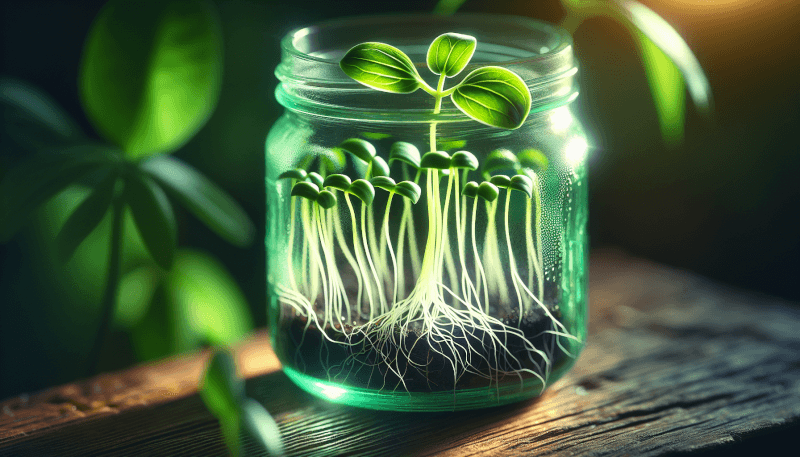So, you’re ready to explore the world of sprouting in a whole new way – in a jar! Whether you’re an experienced gardener or just starting out, sprouting in a jar is a fun and easy way to add fresh and nutritious greens to your daily meals. In this article, we’ll guide you through the simple steps of sprouting in a jar, from choosing the right seeds to caring for and harvesting your sprouts. Get ready to witness the magic of nature unfold as you watch your sprouts grow right before your eyes!
Choosing the Right Sprouts
When it comes to sprouting, the first step is selecting the type of sprouts you want to grow. There are numerous options available, ranging from alfalfa and broccoli to mung bean and radish sprouts. Consider your personal preference and taste preferences when choosing the variety of sprouts you want to grow. If you are new to sprouting, it is recommended to start with easy-to-grow sprouts like lentils or mung beans. Experimentation is key, so feel free to try different types and find the ones that suit your palate best.
Aside from taste, nutritional value is another crucial factor to consider. Different sprouts offer unique nutritional benefits, so it is important to choose ones that align with your dietary needs. For example, broccoli sprouts are known to be rich in antioxidants and vitamins, while alfalfa sprouts are a great source of essential minerals. Research the specific nutritional benefits of each sprout type and select varieties that will enhance your overall health and well-being.
Allergies can also play a role in your selection. Some individuals may have allergies to certain sprouts, so it’s essential to be mindful of any allergies or sensitivities you or your household members may have. Common allergens in sprouts include soy and peanuts. If you or anyone in your household has known allergies, be sure to avoid sprouts that could potentially trigger a reaction.
Preparing the Jar
Once you have chosen the type(s) of sprouts you want to grow, it’s time to prepare the jar for sprouting. Select a jar that is appropriate for the amount of sprouts you plan to grow. Mason jars work well for small to medium-sized batches, while larger containers or trays may be suitable for larger quantities. Ensure that the jar you choose has enough room for the seeds to sprout and grow without becoming overcrowded.
Before using the jar, it is crucial to clean and sterilize it to avoid any potential contamination. Rinse the jar thoroughly with warm water and mild dish soap, paying extra attention to the lid and any crevices. Once cleaned, sterilize the jar by boiling it in water for 10-15 minutes. This step will help eliminate any potential bacteria or pathogens that could hinder the sprouting process.
Creating ventilation is essential for successful sprouting. After sterilizing the jar, ensure proper airflow by puncturing several holes in the lid. The holes should be small enough to prevent the seeds from escaping but large enough to allow for adequate airflow. Ventilation will help prevent excessive moisture and allow for the exchange of gases during the sprouting process.
Soaking the Seeds
To kickstart the sprouting process, soaking the seeds is vital. Start by selecting the correct amount of seeds for your jar. It’s important not to overcrowd the jar, as the seeds need room to expand and sprout. Generally, a tablespoon of seeds for a small jar and two tablespoons for a larger jar should suffice. However, be sure to adjust the quantity based on the sprout variety and your personal preference.
Once you have measured the seeds, give them a quick rinse under running water to remove any dust or debris. This step helps ensure that the sprouts grow in a clean and hygienic environment. After rinsing, transfer the seeds to the prepared jar and add enough water to cover them completely. Let the seeds soak for the recommended time, which varies depending on the sprout variety. Typically, soaking overnight or for 8-12 hours is sufficient, but be sure to refer to specific instructions for the sprout type you have chosen.
Rinsing and Draining
After soaking, rinsing and draining the seeds properly is crucial for their healthy growth. Establishing a rinse schedule will depend on the sprout variety and personal preference. As a general guideline, rinsing the sprouts 2-3 times a day is recommended. Rinse the sprouts under cool running water, gently swirling them around to remove any residue or excess starch.
Proper drainage technique is essential to prevent the sprouts from sitting in stagnant water, which could lead to mold or rot. To ensure effective drainage, tilt the jar at an angle and gently shake or tap it to allow the water to escape through the ventilation holes. Be diligent in thoroughly draining the excess water after each rinse, as moisture control is vital for preventing bacterial growth during the sprouting process.
Maintaining an Optimal Environment
Creating an optimal environment for your sprouts is crucial to their healthy growth and development. Adequate light is essential for sprouts to photosynthesize and obtain the necessary energy for growth. Place the jar near a sunny window or under artificial lighting that mimics natural sunlight. Be cautious of exposing the sprouts to direct sunlight for extended periods, as it can cause overheating or damage to the delicate sprouts.
Temperature and humidity also play significant roles in sprout growth. Most sprouts thrive in temperatures between 60-70°F (15-21°C). Ensure that the sprouts are not exposed to extreme heat or cold, as it can hinder their growth. Likewise, maintaining a humidity level of around 50-70% is ideal for sprouts. If your environment is too dry, consider using a humidifier or placing a tray of water near the sprouts to increase humidity.
While providing adequate light, temperature, and humidity, it’s important to shield the sprouts from direct sunlight. Direct sunlight can be intense and lead to dryness or wilting. Use curtains, blinds, or a thin cloth to filter the sunlight, creating a more controlled environment for your sprouts to thrive.
Preventing Common Issues
Like any gardening endeavor, sprouting can come with its fair share of challenges. Mold and rot are common issues that sprout growers may encounter. To prevent these issues, ensure that the sprouts are not overcrowded and have proper air circulation. Excess moisture is a breeding ground for mold and rot, so maintaining proper moisture control and drainage is vital. Additionally, always use clean and sterilized equipment to minimize the risk of contamination.
Preventing overgrowth is another crucial aspect of sprout cultivation. Overgrown sprouts can become tough and bitter, compromising their taste and texture. Maintain regular rinsing and proper drainage to prevent the sprouts from growing excessively. If you notice the sprouts becoming too long or developing yellow leaves, it may be an indicator of overgrowth. Harvesting at the proper time will help you avoid this issue.
Monitoring Growth and Progress
Monitoring the growth and progress of your sprouts is exciting and important to ensure a successful harvest. Noting the germination time will give you an estimate of when the sprouts should start appearing. Germination periods vary depending on the sprout variety, with some sprouts sprouting as quickly as a few days, while others may take up to a week.
While monitoring their growth, check for signs of maturity. Mature sprouts will have developed leaves or green shoots, indicating that they are ready for harvest. Pay attention to their overall appearance and aroma. If the sprouts have an unpleasant smell or show any signs of discoloration or sliminess, it’s best to discard them and start anew.
Harvesting the Sprouts
Harvesting at the optimal time is crucial for obtaining the best taste and texture from your sprouts. Determining the optimal harvest time depends on personal preference and the sprout variety. Some sprouts are tastiest when harvested as soon as the first leaves appear, while others may develop better flavor and texture when allowed to grow a bit longer.
To harvest sprouts properly, gently remove them from the jar, rinsing them under cool water to remove any remaining hulls or seed coats. Be gentle during this process to avoid damaging the delicate sprouts. After rinsing, allow the sprouts to drain thoroughly before storing or enjoying them in your meals.
Storing and Enjoying Sprouts
After harvesting, proper cleaning and storing practices are essential for preserving the freshness and taste of your sprouts. Clean the sprouts by rinsing them under cool water, removing any hulls or seed coats that may have stayed attached. Pat them dry gently using a clean cloth or paper towel to remove excess moisture.
Storing sprouts in the refrigerator is recommended to maintain their freshness. Transfer the sprouts to an airtight container or a resealable plastic bag lined with a damp paper towel. The paper towel helps retain the sprouts’ moisture while preventing excessive wetness that could lead to spoilage. Stored properly, sprouts can stay fresh for up to a week.
Incorporating sprouts into your meals is a great way to enjoy their fresh and crunchy texture. Add them to salads, sandwiches, wraps, or stir-fries for an extra burst of flavors and nutrition. Sprouts also make a delicious topping for soups or a nutritious addition to smoothies. Get creative and experiment with different culinary combinations to find your favorite ways to enjoy sprouts!
Exploring different sprouting methods can also add variety to your sprouting adventures. Besides using a jar, you can try using specialized sprouting trays or automatic sprouting systems. Each method has its advantages and unique growing conditions, allowing you to sprout different varieties simultaneously or grow larger batches effortlessly.
Ensuring Safety and Hygiene
Throughout the process of sprouting, safety and hygiene should always be a top priority. Prioritize cleanliness by using clean hands, utensils, and equipment while handling the sprouts. Wash your hands thoroughly before touching or preparing the sprouts to minimize the risk of contamination.
Avoid contamination by thoroughly washing any equipment used in the sprouting process, such as mason jars, trays, or sprouting systems. Regularly clean and sanitize them using mild dish soap and hot water or a diluted bleach solution. Rinse them thoroughly to remove any cleaning residue before using them again.
By following these guidelines and practicing good hygiene, you can ensure that your sprouting journey is safe and successful. Enjoy the process of sprouting and savor the delicious, nutritious sprouts you bring to life in your own kitchen!



